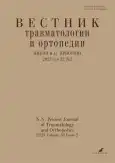Minimally invasive treatment for spinal osteoid osteomas
- Authors: Snetkov A.A.1, Ishkinyaev I.D.1, Gamayunov R.S.1, Klimov V.S.2, Pleskushkina A.S.1, Kolesov S.V.1, Gorbatyuk D.S.1
-
Affiliations:
- Priorov National Medical Research Centre for Traumatology and Orthopaedics
- Federal State Autonomous Educational Institution of Higher Education “Pirogov Russian National Research Medical University”
- Issue: Vol 32, No 2 (2025)
- Pages: 337-345
- Section: Original study articles
- URL: https://journal-vniispk.ru/0869-8678/article/view/314742
- DOI: https://doi.org/10.17816/vto633576
- EDN: https://elibrary.ru/ZQUEOW
- ID: 314742
Cite item
Abstract
BACKGROUND: Osteoid osteomas are benign bone-forming tumors that frequently affect the spine. The primary treatment method is surgical removal of the neoplasm. However, if osteoid osteomas are anatomically difficult to access, surgical intervention may require extensive resection of unaffected bone, resulting in loss of vertebral support and the need for further stabilization. Alternative techniques, such as percutaneous radiofrequency ablation and laser thermal ablation, are highly effective; however, their use is limited due to the proximity of the spinal cord and neural structures. Therefore, advanced navigation systems, as well as minimally invasive and endoscopic approaches, are required to enable localized osteoid osteoma resection without destabilizing the spinal segment. This approach prevents damage to supporting structures, especially when the tumor is located in the middle supporting column of the vertebra, eliminating the need for internal fixation.
AIM: The work aimed to review surgical treatment options in children with confirmed spinal osteoid osteomas and to assess the outcomes of minimally invasive and open surgeries, including in patients with lesions in the middle supporting column.
METHODS: The study included 36 patients diagnosed with spinal osteoid osteoma. The age range was 8 to 18 years. Surgical outcomes were evaluated based on the chosen approach, extent of resection, and the use of internal fixation.
RESULTS: Radiofrequency ablation was successfully performed in four patients with lesions located in thermally accessible areas. Open surgeries were performed in 32 cases. The most challenging cases were reported in seven patients with tumors located in the middle supporting column. Patients who underwent minimally invasive procedures had a shorter recovery period than those who had conventional (open) surgery.
CONCLUSION: A personalized surgical strategy, taking into account tumor location and optimal access route, with the use of advanced minimally invasive techniques, allows for optimal treatment outcomes in children with spinal osteoid osteomas. This approach ensures complete tumor resection with minimal surgical intervention, while preserving spinal column function.
Full Text
##article.viewOnOriginalSite##About the authors
Aleksandr A. Snetkov
Priorov National Medical Research Centre for Traumatology and Orthopaedics
Email: isnetkov@gmail.com
ORCID iD: 0000-0001-5837-9584
SPIN-code: 8901-4259
MD, Cand. Sci. (Medicine)
Russian Federation, 10 Priorova st, Moscow, 127299Ilyas D. Ishkinyaev
Priorov National Medical Research Centre for Traumatology and Orthopaedics
Email: ilyas.ishkinyaev@gmail.com
ORCID iD: 0009-0003-2228-1405
MD
Russian Federation, 10 Priorova st, Moscow, 127299Roman S. Gamayunov
Priorov National Medical Research Centre for Traumatology and Orthopaedics
Email: cito11@hotbox.ru
ORCID iD: 0000-0002-9960-9427
SPIN-code: 2451-9875
MD
Russian Federation, 10 Priorova st, Moscow, 127299Vladimir S. Klimov
Federal State Autonomous Educational Institution of Higher Education “Pirogov Russian National Research Medical University”
Email: klimov-vs@rambler.ru
ORCID iD: 0000-0002-9096-7594
SPIN-code: 1333-2654
MD, Dr. Sci. (Medicine), Professor; Separate structural subdivision — Research Clinical Institute of Paediatrics and Children’s Surgery named after Academician Y.E. Veltischev
Russian Federation, MoscowAnna S. Pleskushkina
Priorov National Medical Research Centre for Traumatology and Orthopaedics
Author for correspondence.
Email: dr.pleskushkina@yandex.ru
ORCID iD: 0009-0008-9687-6483
SPIN-code: 7937-8752
MD
Russian Federation, 10 Priorova st, Moscow, 127299Sergey V. Kolesov
Priorov National Medical Research Centre for Traumatology and Orthopaedics
Email: dr-kolesov@yandex.ru
ORCID iD: 0000-0001-9657-8584
SPIN-code: 1989-6994
MD, Dr. Sci. (Medicine), Professor
Russian Federation, 10 Priorova st, Moscow, 127299Dmitry S. Gorbatyuk
Priorov National Medical Research Centre for Traumatology and Orthopaedics
Email: naddis@mail.ru
ORCID iD: 0000-0001-8938-2321
SPIN-code: 7686-2123
MD
Russian Federation, 10 Priorova st, Moscow, 127299References
- Sangiorgio A, Oldrini LM, Candrian C, Errani C, Filardo G. Radiofrequency Ablation Is as Safe and Effective as Surgical Excision for Spinal Osteoid Osteoma: A Systematic Review and Meta-Analysis. Eur Spine J. 2023;32(1):210–220. doi: 10.1007/s00586-022-07411-8
- Sagoo NS, Haider AS, Chen AL, et al. Radiofrequency Ablation for Spinal Osteoid Osteoma: A Systematic Review of Safety and Treatment Outcomes. Surg Oncol. 2022;41:101747. doi: 10.1016/j.suronc.2022.101747
- Tepelenis K, Skandalakis GP, Papathanakos G, et al. Osteoid Osteoma: An Updated Review of Epidemiology, Pathogenesis, Clinical Presentation, Radiological Features, and Treatment Option. In Vivo. 2021;35(4):1929–1938. doi: 10.21873/invivo.12459
- Teixeira PAG, Chanson A, Beaumont M, et al. Dynamic MR Imaging of Osteoid Osteomas: Correlation of Semiquantitative and Quantitative Perfusion Parameters with Patient Symptoms and Treatment Outcome. Eur Radiol. 2013;23(9):2602–2611. doi: 10.1007/s00330-013-2867-1
- Salame K, Lidar Z, Khashan M, Ofir D, Regev GJ. Minimally Invasive Resection of Benign Osseous Tumors of the Spinal Column: 10 Years’ Experience and Long-Term Outcomes of a Specialized Center. Medicina (Mex.). 2022;58(12):1840. doi: 10.3390/medicina58121840
- Pipola V, Tedesco G, Spinnato P, et al. Surgery Versus Radiofrequency Ablation in the Management of Spinal Osteoid Osteomas: A Spine Oncology Referral Center Comparison Analysis of 138 Cases. World Neurosurg. 2021;145:e298–e304. doi: 10.1016/j.wneu.2020.10.050
- Gasbarrini A, Cappuccio M, Bandiera S, et al. Osteoid Osteoma of the Mobile Spine: Surgical Outcomes in 81 Patients. Spine. 2011;36(24):2089–2093. doi: 10.1097/BRS.0b013e3181ffeb5e
- Mironov SP, Snetkov AI, Batrakov SY. Diagnosis and treatment of benign tumors and tumor-like bone diseases in children. Mironov SP, editor. Moscow: GEOTAR-Media; 2017. 352 р. (In Russ.). EDN: ZRPKMZ
- Kesyan OG. Osteoid osteoma and osteoblastoma of the spine in children: clinic, diagnosis, treatment [dissertation]. Moscow; 2017. 22 p. (In Russ.). EDN: ZQEJWX
- Rehnitz C, Sprengel SD, Lehner B, et al. CT-Guided Radiofrequency Ablation of Osteoid Osteoma and Osteoblastoma: Clinical Success and Long-Term Follow up in 77 Patients. Eur J Radiol. 2012;81(11):3426–3434. doi: 10.1016/j.ejrad.2012.04.037
- Liu R, Tian J, Yuan J, et al. Computer-Assisted Navigation Full Visualization Spinal Endoscopic Surgery for Lumbar Vertebral Osteoid Osteoma. Orthop Surg. 2023;15(9):2464–2470. doi: 10.1111/os.13801
- Kulkarni A, Patel A. Motion Preservation Surgery: Excision of Juxta C5–C6 Intervertebral Disc Osteoid Osteoma Using 3D C-Arm Based Navigation: Technical Report. SICOT-J. 2018;4:56. doi: 10.1051/sicotj/2018052
- Jho DH, Jho DH, Jho H-D. Anterior Cervical Foraminotomy (Jho Procedure). In: Schmidek and Sweet Operative Neurosurgical Techniques. Elsevier; 2012:1757–1769. doi: 10.1016/B978-1-4160-6839-6.10152-2
Supplementary files












